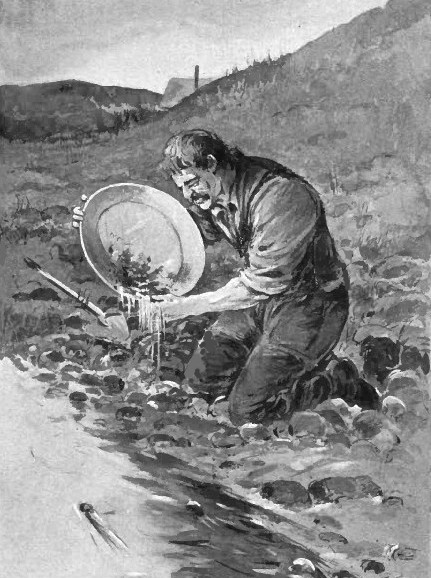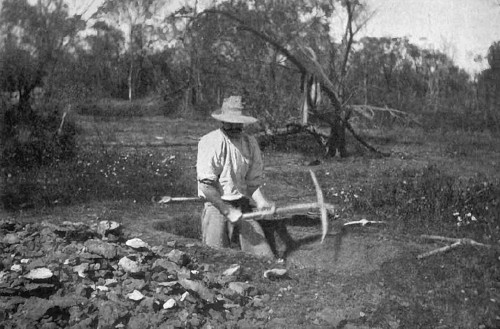1. Types of
Placer Deposits
2. Relation of Gold Placers to Gold Lodes
3. Stream Placer Formation and Pay Streaks
4. Prospecting For Placer Gold
5. Beach Mining For Shoreline Gold
6. An Explanation of Coarse Gold Formation
7. Gigantic Nugget Finds Worldwide
8. World Class Placer Gold Districts
9. Historic Placer Gold Mining Methods
10. About Platinum Placers
Recommended
Metal Detectors
For Gold Prospecting:
Gold always occurs in gravels in the metallic state and when so found has various physical characteristics that are well known to prospectors. Gold is dense and heavy, it has a characteristic yellow metallic color, and it is soft and easily malleable (it is easily shaped or formed by hammering). These are some of the best known characteristics which are used by prospectors to identify gold nuggets in the field. For more images and information on natural gold, see gold nuggets.
However, sometimes in the deep and buried ancient placers it has no luster, being heavily coated and having no appearance of gold whatever, resembling the associated iron sands. I have found gold that has never traveled in any stream that is completely coated in iron oxides, with no visible gold showing until the nugget was cleaned. In the shallow placers, however, the gold usually has more of the expected metallic appearance, although varying considerably in color. "Prospecting" is the search for gold. The instruments used by the prospector for placer-mines are usually the pan, pick and shovel. He should be familiar with the general laws of the distribution of gold, and then try the dirt in the most favorable places. If there is any gold in a district, he can scarcely fail to find specks of it by washing dirt, from the bed-rock in the ravines, and in bars. The existence of gold in a district having been established, close observation will suggest to the prospector where he may reasonably expect to find the best diggings. It is usually found that placer-gold is collected in those places where, if he had been familiar with the ancient topography of the country, he should have had reason to suppose that it would be.
Size of the Placer Gold.
Gold is found varying in size from the smallest particles to large nuggets.
That of the size of flax and melon seed being considered coarse, while all
under that is fine. The top gravels usually carry fine gold of high-grade,
the coarser being nearer bedrock.
Although the larger part of the gold in California is fine or moderately
fine, large nuggets are sometimes found and much speculation has been
indulged in as to their origin. The largest masses of gold found in
California are said to be that from Carson Hill, which weighed 195 pounds
troy, and that from the Monumental
quartz
mine, in Sierra County, which weighed about 100 pounds troy. The mass at
Carson hill, if not directly in a quartz vein, was at any rate immediately
below the croppings and not in any well-defined alluvial channel. The
well-known heavy nuggets obtained near Columbia, Tuolumne County, were found
in a vicinity of rich pocket veins where decay of rocks has proceeded
without much interference since Tertiary time, and in which assuredly there
has been little transportation. Heavy masses of gold are exceedingly common
in the so-called pocket veins of Sonora. Many of the veins near Alleghany
and Minnesota, in Sierra County, contain remarkably heavy masses of gold.
Hanks,' in his list of nuggets found in California, states that a slab of
gold quartz extracted from the Rainbow mine, near the locality just
mentioned, was calculated to contain gold to the value of $20,468. The total
yield from a single pocket of this mine was $116,337. The Ballarat nuggets,
some of which weighed from 100 to 200 pounds, found near the town of
Ballarat, in Victoria, Australia, are often quoted as conspicuous examples
of masses of gold

The gold in the larger channels of the Sierra Nevada is usually fine to medium fine. Grains of the size of wheat kernels are considered as being very coarse gold, and in most places the size of the average grain corresponds more nearly to that of a mustard seed. In form most of the grains are flattened, a natural result of the continual pounding of the particles by the cobbles in the moving gravel. A certain proportion of the gold is extremely fine, and this part constitutes the so-called flour gold, which may be so fine that one or two thousand particles must be obtained to get even a very small value. Few systematic investigations are available regarding the proportion of coarse and fine gold in the channels, and the various localities show indeed great divergence. The data given by Hanks and Blake regarding the occurrence of nuggets show that in the main channels large masses of gold are on the whole rare.
Most of the larger masses noted are from gulches or minor streams close to croppings. Very coarse gold was found in the tributary channel extending from Minnesota to Forest. In the Live Yankee claim, at Forest, 12 nuggets were found weighing from 30 to 170 ounces. At Remington Hill and Lowell Hill, in Nevada County, both of which are on a tributary to the main river, pieces weighing from 58 to 186 ounces are recorded. The gold is rarely found in the quartz pebbles and boulders of the channels; however, Blake records the discovery at the Polar Star mine of a white quartz bolder which yielded gold to the value of $5,760. This is in the gravel of a principal tributary to the Tertiary Yuba River, at a point where the contact of slates with the "Serpentine belt" is crossed. The White channel, mined by the Hidden Treasure mine, contains rather unusually coarse gold. It is a broad gravel deposit, 800 feet wide in places, accumulated on a tributary to the main river descending by way of Long Canyon, Michigan Bluff, and Forest Hill. The coarse gold is explained by the fact that the stream followed a belt of clay slate rich in auriferous quartz veins. Some very rich placer deposits for instance, those of the Klondike, Yukon Territory, and the Berry mines in Victoria, Australia contain no especially large or gigantic pieces of gold.
Some placer gold occurs in rounded grains, many of which have pitted surfaces, but most of the pieces are flat. Small nuggets of a value of 10 to 50 cents are common, and larger pieces worth from $10 to $400 are occasionally encountered. At the celebrated Morning Star and Big Dipper drift mines, at Iowa Hill, the gold is also decidedly coarse, some pieces of a value up to $20 being found, but at other places along the same main branch of the Tertiary Yuba River much finer gold prevails, and a small part of it, which is difficult to recover, can even be classed as flour gold. Blake states that in the deep channels at You Bet, in Placer County, the gravel is in some places literally packed with small scale gold. He found that in a sample from American River the scales averaged less than 1 millimeter in diameter. The thickness is usually from one-third to one-fifth of the diameter. On the whole, it may be said that flour gold, such as is found in the beaches of the California and Oregon coasts or in the sands of Snake River, is not abundant in the Tertiary gravels of California.
The origin, occurrence, and character of shallow placer diggings vary considerably. Old time prospectors have established half a dozen rules deduced from the method of formation of gold placer diggings that have been singularly verified in practice:
1. Placers in place will be likely to carry metals in quantity and distribution like the original deposits from which they are derived.
2. Alluvial placers of accumulation will be richest in those places where the current of the stream was interrupted by a diminution in its fall, by sudden change of direction, or by the entrance of a tributary; also by reefs, bars, and eddies. The absolute richness, however, depends upon local circumstances, and the size and weight of the gold nuggets must be taken into consideration.
3. Though gold is concentrated along bedrock, the small depressions, crevices, holes, and fissures in the bed rock over which the stream gravels pass are frequently especially rich as the gold is more or less permanently caught in these places.

4. The lowest layers of each "period of deposition" are usually the richest.
5. Sometimes, however, several periods of deposition have succeeded each other; and thus several rich strata may occur in the same ground, with the bottom of each level being a "false bedrock".
6. Not only the courses of present streams, but gravel benches left by erosion and especially, the ancient channels, now left behind by the water, are the localities of placers.
Associated Minerals:
Placer deposits may contain a number of heavy minerals, which settle out
with the gold in the sluice boxes. The minerals and metals occurring in
gravel deposits naturally consist of those found in the rock traversed by
the streams forming the placers, but there are certain minerals almost
always present. These include
pyrite,
magnetite, ilmenite, (black
sand), garnet and zircon (heavy white sand). Other rare concentrate minerals
can include monazite (heavy yellow sand),
cassiterite,
platinum, osmiridium, rutile,
epidote, chlorite, topaz, barite and even diamonds. Pyrite or marcasite may
actually form in the gravels from flowing waters.
Other occasional associates of gold, probably derived from its
primary deposits, are silver in nuggets (Alaska), native bismuth (Queensland
and Alaska), native amalgam, palladium-gold,
native copper, and
cinnabar .
While the quartz pebbles so abundantly found in many gold-bearing
gravels do not ordinarily contain visible gold, there are many instances of
such occurrences for example, at Elk City and Idaho City, Idaho, and at
Dutch Flat and Nevada City, California.
Historic Discoveries of Gold:
The first commercially important discovery in the US was on the Reed
farm in North Carolina, but by far the most important was in California in
1848. Discovery of placer normally precedes the discovery of lode or vein
gold because placer is so
much easier to find. However, because they are the first to be found and
easiest to work, the best of the placers are normally the first to be
exhausted, so the best deposits of old and long-settled regions were
generally long ago exhausted. New deposits have been usually discovered on
the outskirts of the existing civilization, as in Brazil in the eighteenth
century, in Australia and California during the middle of the 19th
century, and in Alaska and Siberia early in the 1900s. Placer gold is still
the goal of many individual prospectors and other small operators. This
article and the other materials on this website are intended to help the
prospector understand and find their own deposits.
Placer gold has been found at one spot or another in a majority of states in the US. Some states have no deposits that are economically viable for mining (as in the glacial gravel deposits of the Midwest). In the Southeastern US and even more in the western US states millions of ounces of placer gold have been mined, and the gravel deposits have been very productive. The gold does not occur randomly, but in and around rocks that contain gold deposits.

